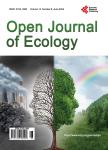Evaluation of the Above-Ground Biomass of Steppe Ecosystems According to Their Stage of Degradation: Case of the Area of Ain Skhouna (Western Algeria)
Evaluation of the Above-Ground Biomass of Steppe Ecosystems According to Their Stage of Degradation: Case of the Area of Ain Skhouna (Western Algeria)作者机构:INRF Ain-Skhouna Saida Algeria Laboratory of Ecology and Natural Ecosystem Management University of Tlemcen Tlemcen Algeria Faculty of Science University of Dr Tahar Moulay Saida Algeria
出 版 物:《Open Journal of Ecology》 (生态学期刊(英文))
年 卷 期:2016年第6卷第5期
页 面:235-242页
学科分类:0710[理学-生物学] 071001[理学-植物学] 07[理学]
主 题:Vegetation Evaluation Biomass Degradation Ain Skhouna Algeria
摘 要:The steppe in the region of Ain Skhouna (Department of Saida) includes three major vegetation types: Stipa tenacissima, Artemisia herba alba and Lygeum spartum. They have a very important ecological and socio-economic role. Nevertheless, they are exposed to a threat of deterioration due essentially to a combination of adverse climate circumstances and human impact. In the field, we found three physiognomic stages for each type of vegetation: degraded, moderately degraded and well growing. For a better comprehension of the process of each facies, we considered that the dynamic of the above-ground biomass is an interesting indicator for quantifying the degree of degradation of the steppic ecosystems. For that, we have adopted a combined method: linear transects and vegetation harvests over a one-square meter surface. This approach allowed us to identify the chosen site taxa on the one hand and quantify the above-ground biomass of each plot on the other hand. The obtained results reveal a significant regression of the above-ground biomass when moving from one site to another. The values about the Stipa formations present an average biomass oscillating between 1024 and 271.7 kg DM/ha for perennial species and between 367 and 68.8 kg DM/ha for annuals. Those about Artemisia formations fluctuate between 3584 and 805 kg DM/ha for perennials and between 524 and 66 kg DM/ha for annuals. Those about Lygeum formations oscillate between 274.4 and 87.9 kg DM/ha for perennial species accompanying Lygeum spartum and between 162.3 and 31.6 kg DM/ha for annuals.



